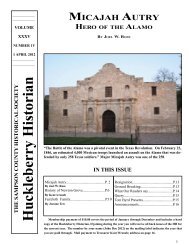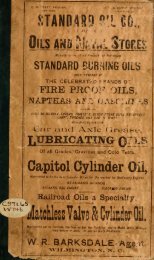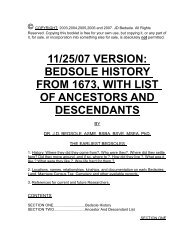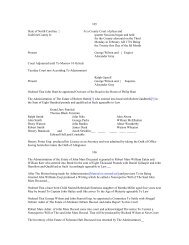Bedsole - NCGenWeb
Bedsole - NCGenWeb
Bedsole - NCGenWeb
You also want an ePaper? Increase the reach of your titles
YUMPU automatically turns print PDFs into web optimized ePapers that Google loves.
Everybody constantly slid or fell into the river and stayed wet all night. Another big job which went with this<br />
was spending two to three days hunting and collecting "Puppy dogs" (salamanders, or spring lizards), for<br />
bait. They hid under logs and stumps and piles of wet leaves in the swamps, but only in the swamps, which<br />
meant you had to slog through the muddy, nasty, swamp. This was the only bait which was free and which<br />
the big "Channel cat" catfish would bite.<br />
People couldn't afford to waste time and energy on anything fish would not bite. This exercise was to<br />
produce food for starving families. It was not a side dish, nor something they picked up at the supermarket,<br />
since there was no such thing then. They were fishing for their families to have food and for their very lives.<br />
The next day, it usually took several people an entire day to skin and clean the catfish, cut them up and fry<br />
them. At the table to eat, needless to say, was any neighbor crowd who had gotten the word.<br />
. EARLY INDIAN PROBLEMS<br />
Although indian attacks on white settlers and settlements, in Virginia are listed below, they are only<br />
examples. Indians were just as adversarial and warlike in North Carolina too. For those <strong>Bedsole</strong>s who were<br />
living here prior to 1800, indians were almost a constant problem and that was true for all states which were<br />
initially "Settled" by pioneers. On top of all the day to day hardships our ancestors were already suffering,<br />
they were frequently savagely attacked and murdered by indians. The examples listed further on, are also<br />
listed in the unpublished manuscript, "Dunsmores Indian Massacres", in the Archives of the Virginia State<br />
Library.<br />
"The Indians are coming up the Sandy," was the first cry of many a Virginia border spy when he rushed into<br />
one of the frontier forts. The report would bring hurried preparations for defense, and fleet runners would<br />
rush off to warn the scattered pioneers to seek the security of the forts. Low gaps through the Cumberlands<br />
were ingresses into Virginia for the dreaded Shawnee from the Scioto and other Ohio points. When the<br />
heavy snows of their midcontinent climate melted and the first signs of spring appeared, the redskins stirred<br />
from their lethargy of long inaction and turned toward the Sandy Passes into Virginia. Beyond the gaps of the<br />
mountain wall were pioneer settlements and scattered cabin homes. To the indians, there was plunder and<br />
many scalps to be taken. Virginians called the gaps "the Sandy Passes" and kept scouts patrolling beyond<br />
them into a wilderness known as the Scouting Ground, in order to provide as much advance notice as<br />
possible for preparation, prior to an impending attack. Some indians came through the gap at the head of the<br />
" Dry Fork of Tug River", others through the passes at the head of the Tug.<br />
For the frontier settlers, Scouts or spies as many called them, were selected from volunteers. They were<br />
rugged, self-reliant, courageous, and dreaded little the loneliness of days on the march deep down Big<br />
Sandy, Tug Fork or the Kentucky rivers. They went in two's or four's, carried food for the duration of their<br />
journeys. They were forbidden to use their guns except in the direst emergencies, were forbidden even to<br />
build a fire. Skulking Indians might hear or see and ambush them. Many a frontier settlements and cabins<br />
went up in flames and its inhabitants carried off or massacreed because its protecting scouts were killed, or<br />
did'nt detect an impending attack. Isolated cabins were the most vulnerable to attacks. Here are just a few<br />
examples of the savage atrocities commited against these settlers. Many more and much worse, widespread<br />
cases occurred to those who lived in the earlier "settlements" of 1605-1780, when and where there were no<br />
army post to help protect the "Frontiers", of these increasing and expanding early settlements.<br />
PAGE THIRTY<br />
Jessee Adams, Russell County, Virginia. Him, his wife and ten children were massacred by the Indians on<br />
Stock Creek in 1782. His two brothers are said to have also been killed by Indians near Fort Blackmore in<br />
1790.










